The Intel Optane SSD 800p (58GB & 118GB) Review: Almost The Right Size
by Billy Tallis on March 8, 2018 5:15 PM ESTAnandTech Storage Bench - Light
Our Light storage test has relatively more sequential accesses and lower queue depths than The Destroyer or the Heavy test, and it's by far the shortest test overall. It's based largely on applications that aren't highly dependent on storage performance, so this is a test more of application launch times and file load times. This test can be seen as the sum of all the little delays in daily usage, but with the idle times trimmed to 25ms it takes less than half an hour to run. Details of the Light test can be found here. As with the ATSB Heavy test, this test is run with the drive both freshly erased and empty, and after filling the drive with sequential writes.

The Light test allows the flash-based SSDs to make the most of their write caching throughout the test, so even the 900p is surpassed by the Samsung NVMe SSDs while the 800p ranks with the budget NVMe drives. When the drives are full and the flash-based SSDs get bogged down with garbage collection, the 900p comes out ahead but the 800p still trails behind the Samsung 960 PRO. The VROC configuration look especially poor in terms of average data rate, and the RAID-5 performance is surprisingly low.
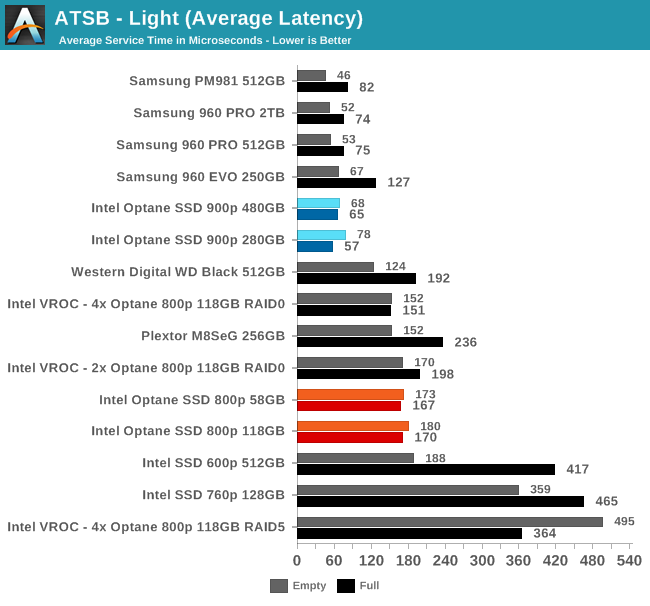

The Optane SSD 800p scores in the middle tier of SSDs for average latency on the Light test, and VROC RAID is no help here. VROC does help with the 99th percentile latencies, but without it the 800p looks like a low-end drive that merely doesn't have garbage collection problems.
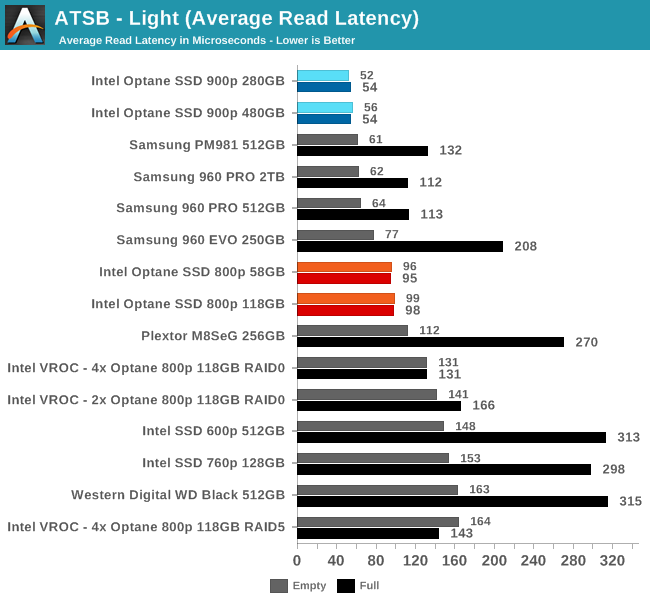
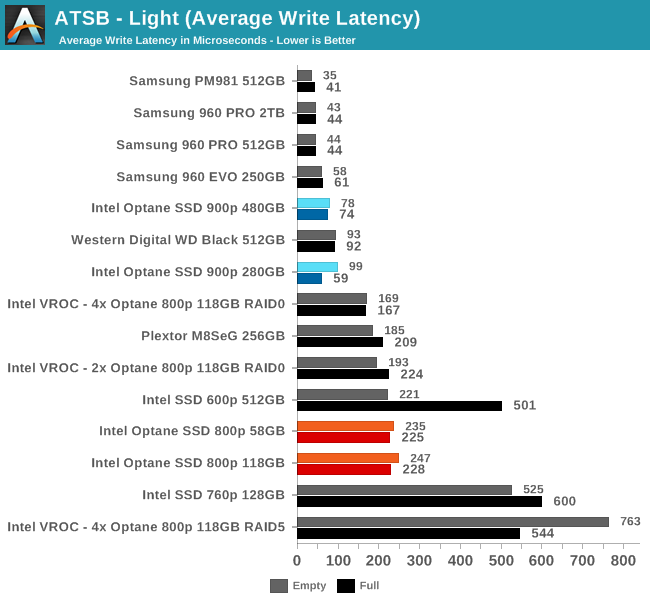
The average read latencies from the 800p are almost twice as high as those from the 900p, and VROC's overhead only makes it worse. The average write latencies of the 900p aren't as good as the best flash-based SSDs, and the write latency of the 800p is well over twice that of the 900p.
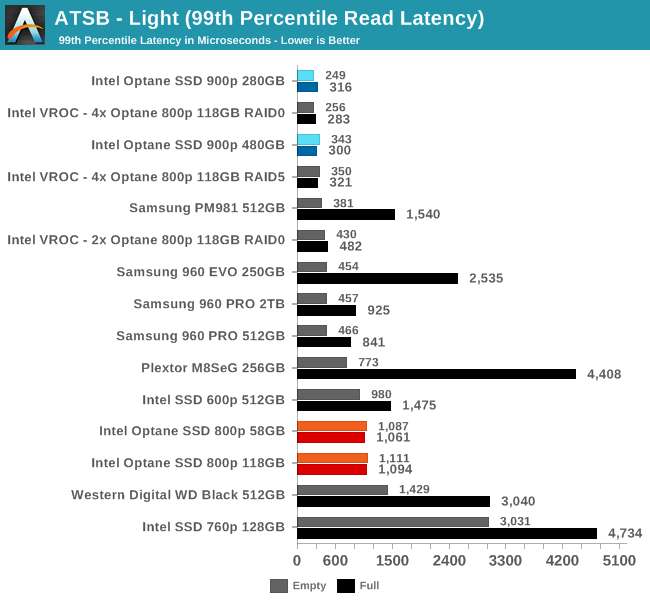
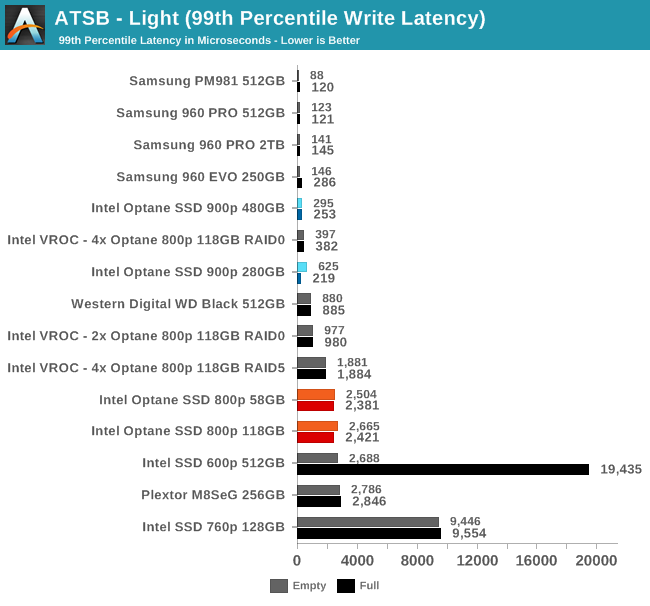
The 99th percentile latency scores from the 800p are not great, but at least the drives perform just as well when full. Small flash-based drives are the most heavily affected when constant garbage collection becomes necessary.
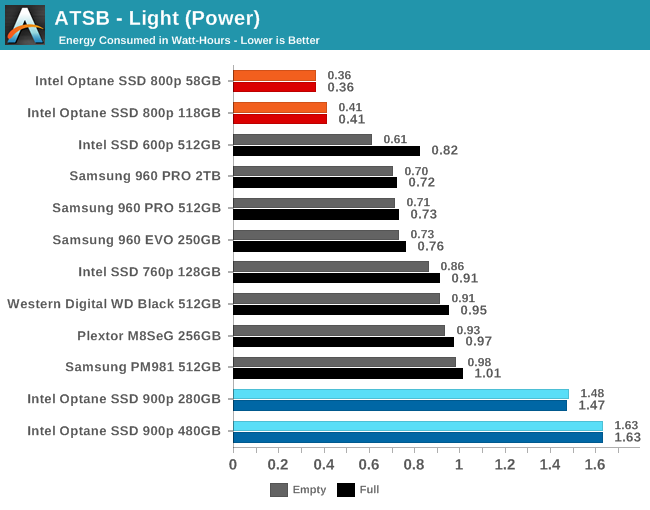
The Light test is a fairly short run with any of these drives, but the 800p still manages to return extremely good power usage numbers that are well ahead of any flash-based NVMe SSD.










116 Comments
View All Comments
Hurr Durr - Thursday, March 8, 2018 - link
Hypetane!iter - Thursday, March 8, 2018 - link
optane = hypetanex-point = xtra-pointless
It keeps getting worse and worse instead of getting better. The next x-point iteration may slip below nand even in the few strong points of the technology.
Also, it doesn't seem that enterprise is very interested in intel's offering, seeing how they struggle to cram the product in market niches where it is xtra-pointless, I'd go on a limb and assume that's not because of love for consumers or skipping on them fat enterprise product margins.
Also, it seems that intel gave very misleading information not only in terms of performance, but also regarding the origin of the technology. The official story is its development began in 2012 as a joint venture between intel and micron.
That however is not true, x-point can be traced back to a now erased from history company named Unity Semiconductors, which was flogging the tech back in 2009 under the CMOx moniker.
Courtesy of archive.org, there is still some trace of that, along with several PDFs explaining the operational principle of what intel has been highly secretive about:
https://web.archive.org/web/20120205085357/http://...
All in all, the secrecy might have to do with intel's inability to deliver on the highly ambitious expectations of the actual designers of the tech. It is nowhere near the 200% better than nand density, in fact it seems at the current manufacturing node it won't be possible to make more than 256 gb in m2 form factor, which is 8 times less than mlc nand or 24 times less than what was projected in 2009. Performance is not all that stellar too, a tad lower than what slc was capable at back in 2012, thank the gods nobody makes slc anymore, so there's a ray of sun to make xtra-pointless hypetane look good on paper.
chrnochime - Thursday, March 8, 2018 - link
Rambus renamed it to ReRAM according to this article in 2015, so it would seem the tech lived on through Rambus after the aquisition of Unity Semi.https://www.eetimes.com/document.asp?doc_id=132552...
But I'm not sure if it's the exact same tech as Intel's.
iter - Thursday, March 8, 2018 - link
Check the PDFs, what little intel posted about it is all there. They may have licensed the tech from rambus. It is not like rambus does anything other than patent milking anyway.iter - Thursday, March 8, 2018 - link
"Coincidentally", rambus bought unity in 2012, exactly when intel allegedly started developing...MDD1963 - Friday, March 23, 2018 - link
Not everyone remembers a few sticks of RAMBUS RDIMMS for some Pentium 3 boards costing $500-$600 a stick back in '99-'00....; and being outperformed by DDR. Nice job, RAMBUS!tommo1982 - Thursday, March 8, 2018 - link
Am I reading it right? Was Cross-point memory supposed to be cheaper than NAND?WinterCharm - Thursday, March 8, 2018 - link
Yes. But I guess we won't see that for a while.Latency and power consumption are great... but speed and capacity leave a lot to be desired. When MacBook Pros have NVME drives capable of 3.2 GB/s (yes gigabytes) at a 2TB capacity... Optane is far behind.
There are some advantages, but I expect that Intel will need to do a lot more work before these are cheaper, faster, and have higher capacity.
Reflex - Friday, March 9, 2018 - link
That said, latency is what users notice. Max speed is a rarely encountered scenario in most user workloads.iter - Saturday, March 10, 2018 - link
No human notices microseconds. Delay becomes noticeable at about 10-20 msec, depending on the individual's reflexes, becomes annoying at about 50 msecs, and becomes detrimental at 200+.10 mseconds is 10000 microseconds. Hypetane improves things in the double digit microseconds range. Humans cannot notice that, not today, not in a million years.